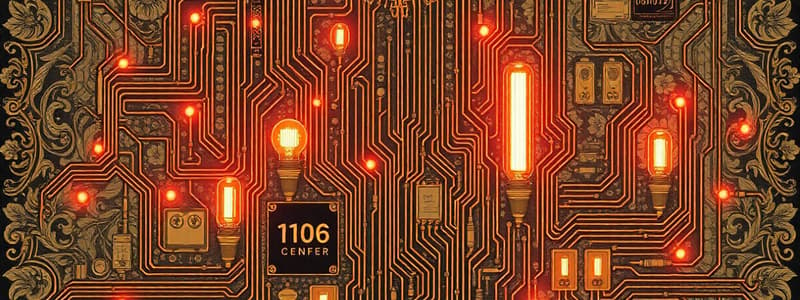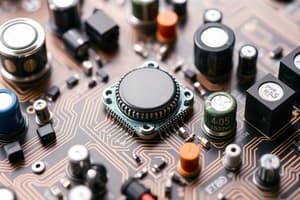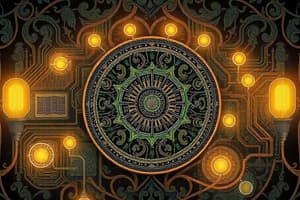Podcast
Questions and Answers
What is the unit of electric current?
What is the unit of electric current?
- Volts
- Watts
- Amperes (correct)
- Ohms
Which circuit type has the same voltage across all components?
Which circuit type has the same voltage across all components?
- Parallel Circuit (correct)
- Series Circuit
- Open Circuit
- Closed Circuit
According to Ohm's Law, what happens when resistance increases while voltage remains constant?
According to Ohm's Law, what happens when resistance increases while voltage remains constant?
- Power increases
- Power decreases
- Current decreases (correct)
- Current increases
What function does a capacitor serve in a circuit?
What function does a capacitor serve in a circuit?
Which law states that the sum of the currents entering a junction must equal the sum of the currents leaving it?
Which law states that the sum of the currents entering a junction must equal the sum of the currents leaving it?
Which of the following describes an analog signal?
Which of the following describes an analog signal?
What is the main purpose of a resistor in a circuit?
What is the main purpose of a resistor in a circuit?
In which type of current does the flow of electric charge change direction periodically?
In which type of current does the flow of electric charge change direction periodically?
Flashcards are hidden until you start studying
Study Notes
Fundamentals of Basic Electronic Engineering
-
Basic Concepts
- Voltage (V): Electric potential difference between two points.
- Current (I): Flow of electric charge, measured in Amperes (A).
- Resistance (R): Opposition to current flow, measured in Ohms (Ω).
- Power (P): Rate of doing work or transferring energy, calculated as P = V × I.
-
Ohm’s Law
- Fundamental relationship between voltage, current, and resistance:
- V = I × R
- Fundamental relationship between voltage, current, and resistance:
-
Circuit Components
- Resistor: Limits current flow; used to divide voltages.
- Capacitor: Stores electrical energy in an electric field; used for filtering and smoothing.
- Inductor: Stores energy in a magnetic field; used in filtering and tuning circuits.
- Diode: Allows current to flow in one direction only; used for rectification.
- Transistor: Semiconductor device used to amplify or switch electronic signals.
-
Types of Circuits
- Series Circuit: Components connected in a single path; current is the same through all components.
- Parallel Circuit: Components connected across common points; voltage is the same across each component.
-
AC vs. DC
- Direct Current (DC): Electric charge flows in one direction; used in batteries.
- Alternating Current (AC): Electric charge changes direction periodically; used in household power supply.
-
Signal Types
- Analog Signal: Continuous signal representing physical measurements.
- Digital Signal: Discrete signal representing binary values (0s and 1s).
-
Basic Theorems
- Kirchhoff's Laws:
- Current Law (KCL): Total current entering a junction equals total current leaving.
- Voltage Law (KVL): Sum of voltage gains and drops around a closed loop equals zero.
- Kirchhoff's Laws:
-
Tools and Equipment
- Multimeter: Measures voltage, current, and resistance.
- Oscilloscope: Visualizes waveforms of electrical signals.
- Breadboard: Prototyping tool for building circuits without soldering.
-
Safety Precautions
- Always disconnect power before working on circuits.
- Use proper protective gear (gloves, goggles).
- Be aware of capacitor charge and discharge.
-
Applications
- Consumer electronics (phones, computers).
- Communication systems (radios, satellites).
- Control systems (automated processes, robotics).
Summary
Basic electronic engineering involves understanding electrical concepts, components, and circuits, applying laws and theorems, using tools for measurement, and ensuring safety while working on electronic projects.
Basic Concepts
- Voltage (V): The difference in electric potential between two points, driving the current flow.
- Current (I): The rate of flow of electric charge; measured in Amperes (A).
- Resistance (R): The opposition to current flow within a circuit, quantified in Ohms (Ω).
- Power (P): The energy transfer rate, calculated with the formula P = V × I.
- Ohm’s Law: A fundamental principle stating the relationship among voltage, current, and resistance: V = I × R.
Circuit Components
- Resistor: Component that limits the flow of current and divides voltage within the circuit.
- Capacitor: Stores electrical energy temporarily in an electric field, utilized in filtering and smoothing signals.
- Inductor: Stores energy in a magnetic field; essential for filtering and tuning applications.
- Diode: A component that permits current to flow in a single direction, primarily used in rectification processes.
- Transistor: A semiconductor device employed for signal amplification or switching functions in electronic circuits.
Types of Circuits
- Series Circuit: All components are linked in a single path; the same current flows through each component.
- Parallel Circuit: Components connect across common points; voltage remains consistent across all components.
AC vs. DC
- Direct Current (DC): Electric charge flows unidirectionally; commonly found in batteries and charging devices.
- Alternating Current (AC): Electric charge periodically reverses direction; predominantly used in household power supplies.
Signal Types
- Analog Signal: Continuous representation of physical phenomena, allowing for a range of values.
- Digital Signal: Discrete representation consisting of binary values (0s and 1s); used in digital electronics.
Basic Theorems
- Kirchhoff's Current Law (KCL): Asserts that the total current flowing into a junction equals the total current flowing out.
- Kirchhoff's Voltage Law (KVL): States that the sum of all electrical potential differences around a closed loop must equal zero.
Tools and Equipment
- Multimeter: A versatile instrument for measuring voltage, current, and resistance in circuits.
- Oscilloscope: A device that visualizes electrical signal waveforms, providing insights into signal properties.
- Breadboard: A prototyping tool enabling circuit assembly without soldering, facilitating easy modifications.
Safety Precautions
- Always ensure power is disconnected before attempting any circuit modifications.
- Utilize appropriate protective gear such as gloves and goggles to ensure safety.
- Maintain awareness of capacitor discharges which may hold charge even when power is off.
Applications
- Consumer Electronics: Utilized in devices like smartphones and computers.
- Communication Systems: Important in radios, satellites, and other communication technologies.
- Control Systems: Integral to automated processes and robotics for managing operations.
Studying That Suits You
Use AI to generate personalized quizzes and flashcards to suit your learning preferences.




